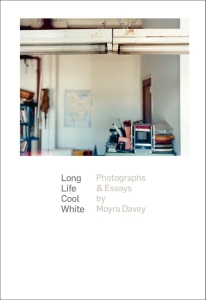Long Life Cool White sounds like the name of a Miles Davis album, so I’ll admit I looked at the titular image of Moyra Davey’s book probably five times before I realized it was referring to the product description on the tube lighting at the top of the frame. Such incidental—or perhaps accidental—details are to be discovered throughout Long Life Cool White, which serves as the catalogue to the exhibition of the same name last spring at the Harvard University Art Museums.
Davey’s work indulges in the descriptive, indexical potential of photography. She acknowledges her anachronism, writing about her anxiety in the face of the Gursky phenomenon. After all she photographs dust, bookshelves, whiskey bottles, and pennies, shoots film negatives and usually prints 20×24. Her photographs are intimate forms of domestic poetry, communicating a reverence for the material world, and the magical translation of making an image. She redeems the worn and used, exalts the analogue and melancholy.
I have admittedly seen her photographs in person only twice, in Photography on Photography at the Met and Arthur Ou’s The World Is All That Is the Case at Hudson Franklin earlier this winter. But the images trigger something, like memories already possessed and then stumbled upon in the dusty corners of the mind. In her photographs, my eye drifts across her desktop, picking up details in the array of objects. A Laura Nyro album, covered by an opaque sheet of wax paper that is slipping away, barely reveals the chanteuse’s dark eyes. The shallow depth of field focusing on fluorescent tubes makes for a decidedly minimalist composition. Weighted heavily to the top of the frame, the eye wanders, looking for the sharp focus and alighting on these surprisingly fascinating objects. If one keeps looking the background begins to emerge: Along the back wall an MTA Subway map is pinned. Atop a table in the lower right appears to be view camera, its back open to the viewer. In Davey’s work objects are embedded with poignant emotional content.
Crucial to this lovely little book is Davey’s essay Notes on Photography and Accident. Davey leads us on a peripatetic, personal journey through her favorite writers on photography. Amidst quotes from Walter Benjamin and Susan Sontag, Davey tells us about her diagnosis with multiple sclerosis, her struggle to take pictures, her ruminations and changing judgments on a book of Annie Leibovitz photographs. The writing is sharp but accessible, tactfully dealing with theory but forgoing the jargon. Inhabiting a mix of genres, it could be called confessional criticism, wonderfully honest in its contradictions and personal admissions. One of the many interesting sections is her appraisal of the relationship between images and the printed page:
I am convinced that reproducibility in book form is part of the vocabulary of the photograph … Is it that, as Benjamin and Brecht speculated, photographs are more at home with, even in need of, words? … I notice that [students’] photographs become vastly more interesting to me after I read what they’ve written about them; I like seeing their images shrunken and recontextualized, embedded in paragraphs of descriptive text.
This ode clearly conflates her love of reading and photography while acknowledging photography’s historical origins from William Fox Talbot’s earliest bound volumes. In contrast to many recent developments in photography, it is very interesting how Davey focuses on the image (rather than object) qualities of a photograph. She delicately uses the “image in book” criteria to redeem classical Eggleston work and indict recent Wolfgang Tillmans large-scale abstractions.
Davey is generous enough to share her candid appraisals on numerous historical and contemporary photographic practitioners—sometimes with surprising positions. So it is exciting to discover shared appreciation for Liz Deschenes, James Welling, Zoe Leonard, and Francesca Woodman. Likewise she uses Leibovitz as an unusual foil for her own work:
Leibovitz describes her method as personal reportage, an expression I’ve never heard before, and she says that when she dives advice to students she tells them to “stay close to home.” My own work could not be further from Leibovitz’s, yet both these terms could be used to describe what I do. And while I don’t want to make what she makes, I do want to look at it, and on a fundamental level I subscribe to the ideas that underpin this particular work.
Just as her writing drifts among quotations and diarist confessions, the viewer of Davey’s photographs is encouraged to wander amidst her possessions, perhaps picking up an open book or album one recognizes, and listening for just a moment, a polite domestic flaneurie.
Tags: Andreas Gursky, Arthur Ou, Books, Francesca Woodman, James Welling, Liz Deschenes, Moyra Davey, Photography, Roland Barthes, Susan Sontag, Walter Benjamin, Zoe Leonard
March 18, 2009 at 3:52 PM |
Moyra Davey is amazing! Thanks for your post!!!
July 29, 2009 at 10:56 PM |
[…] Noise at James Cohan thru August 12. Another chance to see Moyra Davey photographs. And a lot of other things I like, such as Tacita Dean, Robin Rhode, […]
October 26, 2009 at 12:41 PM |
[…] (in una libreria in cui di questi incidenti accadono spesso…), un piccolo saggio-catalogo, Long life cool white, della fotografa Moyra Davey. Allora esiste ancora qualcuno che lavora sui piccoli formati e […]
October 27, 2009 at 7:42 AM |
[…] altre, Moyra Davey sembra adottare con naturalezza un’estetica della recessione. Vi propongo un frammento di recensione della sua mostra più recente dal blog Carefullyaimeddarts (freccettemirate), anonimo e […]